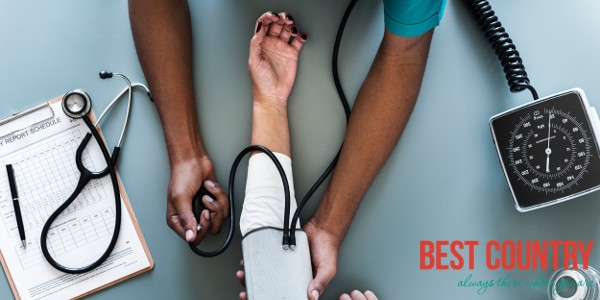Healthcare in Rwanda

Progress was started towards decentralising the health management system, first to the Province level and then to the district level. Unfortunately this was disrupted by the 1994 genocide, which crippled the healthcare system alongside the economy.
In the post genocide period, Rwanda has had an uphill climb in the recovery of their health system as well as their economy. The decentralized multi-tiered system in Rwanda has four referral hospitals, which are Centre Hospitalier Universitaire de Kigali (CHUK), Centre Hospitalier Universitaire de Butare (CHUB), King Faisal Hospital (KFH) and the Kanombe Military Hospital.
It also has a number of dispensaries, 34 health posts which are mainly involved with the outpatient programmes such as immunizations and family planning services, a number of health centres estimated to be over 440, and 48 district hospitals.
In 2008, the government spent 9.7% of national expenditure on healthcare, compared with 3.2% in 1996.Health insurance became mandatory for all individuals in 2008; in 2010 over 90% of the population was covered.
The health insurance is mainly delivered by the Community-Based Health Insurance Scheme, which consists primarily of a social health insurance program called Mutuelles de Santé.
Maternal and child health
Rwanda is one of the countries which is on track in fulfilling the 4th and 5th Millennium Development Goals. In terms of the maternal mortality ratio,it reduced from 1,400 deaths per 100,000 live births in 1990 to 320 deaths per 100,000 live births in 2013.
This was with an average annual rate of reduction to 8.6 from 2000 to 2013.[8] Due to a variety of reasons such as poverty, poor roads due to the hilly terrain in the rural areas, misleading traditional beliefs and inadequate knowledge on pregnancy related issues, 31 percent of the women end up delivering at home despite having a public health insurance scheme.
Some of the solutions which have been sought to the challenges include the training of more community health workers (village health teams) to sensitize the community,on top of providing them with mobile phones to contact the health facilities in emergency situations such as heamorrhage. The number of ambulances to some of the rural health centres have also been increased.
According to a recent report by WHO most of the pregnant women die from hemorrhage (25%), hypertension (16%), abortion and sepsis (10% each) and a small number die from embolism (2%).
The demand for family planning was satisfied by 71% by 2010,the number of women who went for ante natal visits that is 4 or more visits went up to 35% in 2010 which though is low could have probably led to an increase in the number of pregnant women seeking a skilled attendant at delivery from 26% in 1992 to 39% in 2005 and then to 69% in 2010.
In terms of prevention of mother-to-child transmission of HIV,in 2010 the percentage of HIV and pregnant women receiving ante retrovirals drugs rose from 67% to 87% in 2012.
45 percent of women between the ages of 15 to 49, use family planning methods. This comes as no surprise as Rwanda women on average, give birth to 4.6 children throughout their lifetime (RDHS 2010).
Prevalence of some diseases is declining, including the elimination of maternal and neonatal tetanus In 1990 there were 163 under five deaths for every 1000 live births. In 2010, 91 children died before their fifth birthday for every 1000 live births, often from diarrhoea, malaria or pneumonia. However, this figure is improving steadily.
In 1990,the percentage of children immunized against measles was roughly estimated to be 82% and by 2012 it had increased dramatically to 98% coverage of measles,3 doses of hepatitis B, 3 doses if pnuemoccal conjugatevaccine and 3 does of DTP.
Exclusive breast feeding rate increased to 85%.This can be explained by a number of factors such as increased awareness among the populations both rural and urban through education programmes as well as improved coverage of effective interventions. This has been significant in the prevention and treatment of the major causes of child mortality.
The number of malnurished children in Rwanda stil poses as a challenge. The percentage of children under 5 years who were moderately or severely underweight decreased from 24 percent in 1992 to 18% in 2005 to 12% in 2012. Stunting reduced slightly from 57% in 1990 to 44% in 2010.
Water and sanitation
From 1990 to 2012, an improvement in the drinking water coverage was registered from 59% to 67% and the use of surface water reduced from 25% to 11%. There was also an improvement in the sanitation coverage from 1990 to 2012. This was from 30% to 64%. The unimproved sanitary facilities reduced further from 59% to 23%, while open defecation reduced from 7% to 3%.